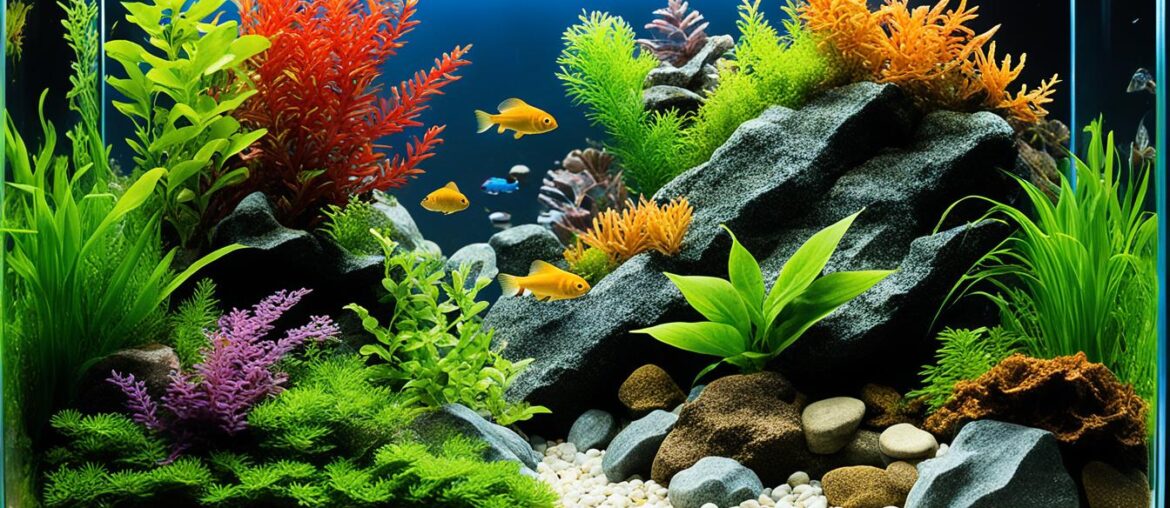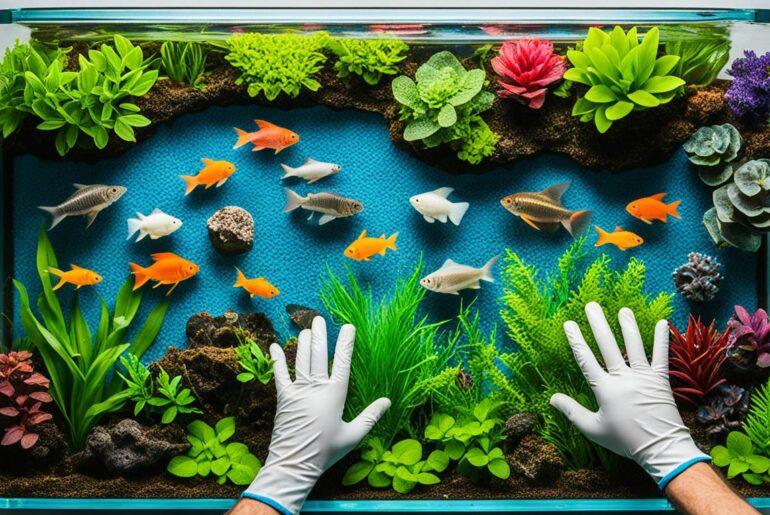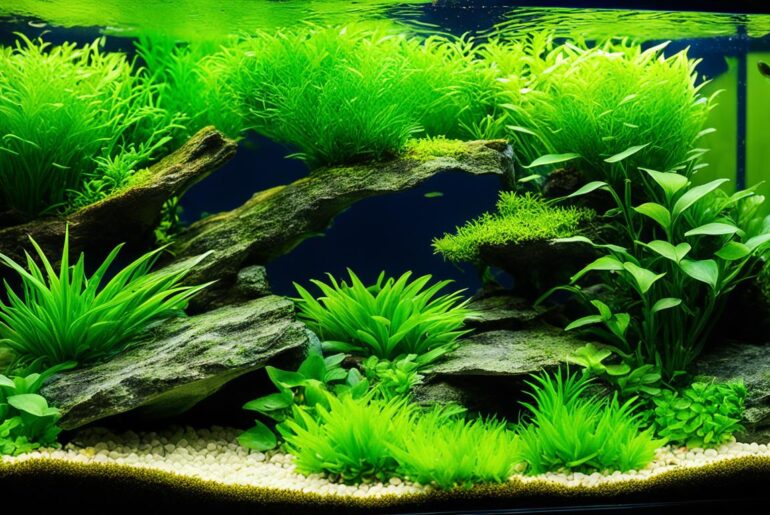Imagine stepping into a world of tranquility, filled with vibrant colors and graceful movement. A world where time stands still, and all your worries melt away. That’s the beauty of a freshwater aquarium. It’s not just a tank with fish; it’s a living, breathing ecosystem that captivates our hearts and souls.
For me, there’s nothing quite like the peaceful serenity that comes from observing the delicate dance of fish gliding through crystal-clear waters. It’s a mesmerizing experience that brings me joy and a sense of connection to the natural world.
But to create a truly thriving aquarium, there’s one crucial element that often goes unnoticed – the substrate. The substrate is the foundation of your aquarium, the very ground on which your aquatic masterpiece is built. It’s not just a decorative touch; it’s an essential component that impacts the health and well-being of your fish and plants.
That’s why I’ve put together this comprehensive guide to help you understand the importance of substrate depth in your freshwater aquarium. Whether you’re a novice or a seasoned aquarium enthusiast, this guide will provide you with the knowledge and insights you need to create a stunning and thriving aquatic paradise.
Key Takeaways:
- Choose the right substrate depth to support the growth of plants and the well-being of your fish.
- Consider the type of substrate that best suits your aquarium’s needs, whether it be pebbles, gravel, sand, or soil.
- Take into account the size of your aquarium and the specific requirements of your fish and plants when determining the ideal substrate depth.
- Remember to maintain and clean your substrate regularly to ensure a healthy and visually appealing aquarium.
- Consider the color of your substrate and how it can impact the behavior and visibility of your fish.
What is a Substrate?
The substrate refers to any loose material that covers the bottom of your aquarium. It can be pebbles, gravel, sand, or soil. The substrate serves various purposes, including enhancing the aquarium’s appearance, creating a natural environment for fish, supporting beneficial bacteria, and providing a rooting medium for plants.
Having the right substrate is crucial for the health and well-being of your aquatic ecosystem. Whether you’re a seasoned aquarium enthusiast or just starting out, understanding the role of substrate is essential for maintaining a thriving aquarium.
“The substrate is the foundation of your aquarium. It not only adds visual appeal but also provides a vital habitat for your fish and plants.” – Dr. Lisa, Aquarist and Marine Biologist
To further illustrate the importance of substrate, let’s take a closer look at the different types of materials commonly used as aquarium substrate: pebbles, gravel, sand, and soil.
Types of Aquarium Substrate
| Type of Substrate | Characteristics |
|---|---|
| Pebbles | Medium to large-sized rocks that provide a natural aesthetic appeal. |
| Gravel | Small to medium-sized stones available in various colors, shapes, and sizes for customization. |
| Sand | Finely textured particles that closely replicate the natural habitat of many aquarium fish. |
| Soil | Specially formulated substrate that provides essential nutrients for plant growth. |
Each type of substrate has its own characteristics and benefits. The choice of substrate will depend on factors such as the type of fish and plants in your aquarium, as well as your personal preference.
Now that we understand what substrate is and the different types available, let’s explore how to choose the right substrate for your aquarium in the next section.
Types of Substrate for Freshwater Aquariums
When it comes to freshwater aquariums, selecting the right substrate is crucial for creating a healthy and visually appealing environment for your aquatic pets. There are several types of substrates commonly used in freshwater aquariums, each offering unique benefits. Let’s explore the different options available:
Pebbles
Pebbles are the largest type of substrate commonly used in aquariums. While they can provide a natural appearance and allow for good water circulation, pebbles also tend to accumulate food particles and waste over time, requiring regular cleaning to maintain water quality.
Gravel
Gravel is a popular choice among aquarium enthusiasts due to its versatility. It comes in various sizes and colors, allowing you to customize the look of your aquarium. Additionally, gravel provides a suitable environment for the colonization of beneficial bacteria, aiding in biological filtration.
Sand
If you’re aiming to mimic the environment of many aquarium fish, sand is an excellent choice. Sand substrates closely resemble the natural habitats of certain species, providing a comfortable and familiar substrate for them to explore and forage. However, it’s essential to select fine-grained sand to prevent any potential harm to delicate fish.
Soil
For planted tanks, soil substrates ensure the successful growth of aquatic plants. They provide essential nutrients and minerals that plants need to thrive, enabling you to create a lush and vibrant underwater garden. Soil substrates also contribute to the overall health of the aquarium ecosystem by supporting the growth of beneficial bacteria.
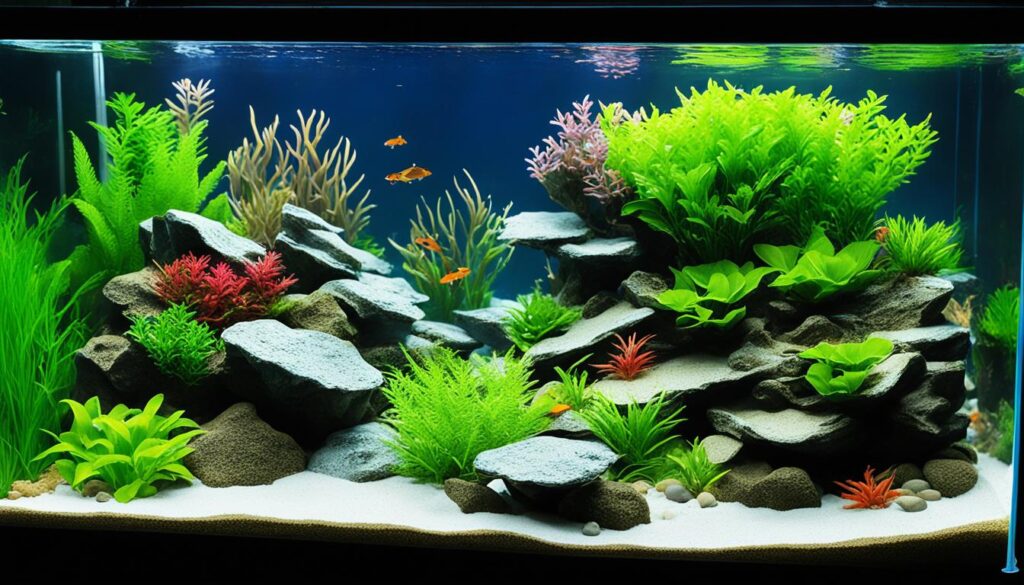
Choosing the right substrate for your freshwater aquarium requires careful consideration of your tank’s specific needs and the wellbeing of your aquatic inhabitants. By understanding the characteristics and benefits of different substrate types, you can create an ideal environment that promotes the health, growth, and natural behavior of your aquarium fish and plants.
Choosing the Right Substrate for Your Aquarium
When it comes to selecting the best substrate for your aquarium, it’s essential to take into consideration the specific needs of your fish, plants, and the overall tank setup. Choosing the right substrate is not only important for the health and well-being of your aquatic pets but also plays a significant role in creating a visually appealing and natural environment.
If you have a planted tank, opting for a nutrient-rich soil substrate is highly recommended. Soil substrates provide essential nutrients to the plant roots, promoting healthy growth and vibrant foliage. Additionally, they improve the overall water quality by assisting in the filtration process. Popular soil substrates include Eco-Complete and Fluval Plant and Shrimp Stratum.
For tanks with bottom-dwelling fish, such as corydoras or loaches, it is crucial to choose a substrate that is smooth and rounded. This helps prevent injuries and discomfort to the delicate skin and barbels of these fish. Options like fine gravel or sand work well for these species, providing a comfortable and safe environment.
Another important aspect to consider is how the chosen substrate complements the other elements in your tank setup. It should blend harmoniously with the rocks, decorations, and overall theme of your aquarium. By choosing a substrate that complements the other components, you can create a cohesive and visually appealing display that enhances the overall aesthetics of your tank.
Remember, the substrate you choose is an integral part of your aquarium’s ecosystem. It not only provides a foundation for your plants and fish but also plays a role in maintaining water quality and facilitating filtration. Take the time to research and understand the specific requirements of your aquarium inhabitants to make an informed substrate choice.
Make a substrate choice that supports the health of your fish and plants, complements your tank setup, and creates a thriving and visually stunning aquatic environment.
In Summary:
- Consider the needs of your fish and plants when choosing a substrate.
- For planted tanks, opt for a nutrient-rich soil substrate.
- Choose a smooth and rounded substrate for bottom-dwelling fish.
- Select a substrate that complements the overall tank setup and theme.
- Create a cohesive and visually appealing aquarium environment.
Factors to Consider When Choosing Substrate Depth
When setting up your freshwater aquarium, selecting the ideal substrate depth is crucial for the overall health and aesthetics of your tank. The right substrate depth not only allows plants to root effectively but also enhances the visual appeal of your aquarium. However, there are a few important factors to consider before determining the depth of your aquarium substrate.
Aquarium Size:
The size of your aquarium plays a significant role in determining the appropriate substrate depth. Larger tanks provide more space for substrate, allowing for a deeper layer. Smaller tanks, on the other hand, may have limitations due to limited space. It is essential to choose a substrate depth that suits the size of your aquarium.
Plant Rooting:
Aquarium plants require a stable and supportive rooting system for healthy growth. To ensure that plants can anchor themselves effectively, it is recommended to provide a substrate depth of at least 3 inches. This depth allows plants to establish strong roots without the risk of floating away.
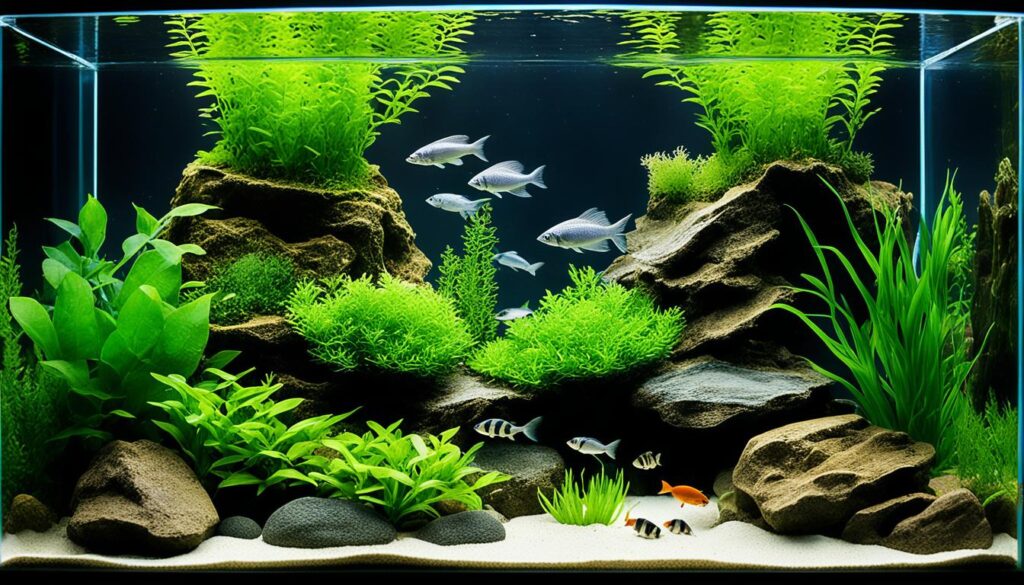
| Aquarium Size | Ideal Substrate Depth |
|---|---|
| Small (10 to 20 gallons) | 2 to 3 inches |
| Medium (30 to 50 gallons) | 3 to 4 inches |
| Large (50 gallons or more) | 4 to 6 inches |
Choosing the Right Substrate Depth:
While a deeper substrate can provide a more visually appealing look, it is important to strike a balance. Excessive substrate depth can limit space for other tank elements such as decorations, hiding spots, or fish swimming areas. Additionally, deep substrate can make cleaning and maintenance more challenging.
“It’s crucial to consider both the needs of your plants and the overall function and design of your aquarium. A thoughtful selection of substrate depth will create a harmonious environment for your aquatic life.”
By considering the size of your aquarium, the rooting requirements of plants, and the practicality of substrate maintenance, you can determine the ideal substrate depth that best suits your freshwater aquarium.
The Impact of Substrate Color in Aquariums
The choice of substrate color in your aquarium is not only a matter of personal preference but can also have an impact on the behavior and visibility of your fish. Different substrate colors can create varying effects in your tank, so it’s important to consider the natural environment of your fish and choose a color that complements their needs.
Natural substrates, such as brown or black, can create a visually appealing and less distracting environment for your fish. These colors mimic the natural habitat of many fish species, providing them with a sense of familiarity. Additionally, darker-colored substrates can help to showcase the vibrant colors of your fish, making them stand out beautifully against the backdrop.
On the other hand, brightly colored substrates, such as blue or pink, can add a pop of color to your aquarium. These colors can create a visually striking contrast and make your fish the center of attention. However, it’s important to note that brightly colored substrates may also cause distractions for some fish species, as they can create an unnatural and unfamiliar environment.
When choosing the color of your substrate, it’s crucial to consider the natural environment of your fish. Research the species you plan to keep and try to replicate their natural habitat as closely as possible. This will help create a sense of comfort and reduce stress for your fish, promoting their overall well-being and natural behavior.
Furthermore, the color of your substrate can also influence the visibility of your fish. Light-colored substrates, such as white or light gray, can make it easier to spot fish that have a darker coloration. Conversely, dark-colored fish may blend in more easily with a dark substrate, making them appear less visible.
Remember, the color of your substrate is just one aspect of creating a natural and visually appealing aquarium environment. Consider factors such as tank decorations, lighting, and the overall layout to create a harmonious and well-balanced habitat for your fish.
Comparison of Substrate Colors and Their Effects
| Substrate Color | Effects |
|---|---|
| Brown or Black | – Mimics the natural habitat – Provides a visually appealing environment – Showcases fish colors |
| Bright Colors (e.g., Blue, Pink) | – Adds a pop of color – Draws attention to fish – May cause distractions for some fish species |
| Light Colors (e.g., White, Light Gray) | – Improves visibility of dark-colored fish – Creates a bright and airy atmosphere |
It’s important to note that while substrate color can have an impact on your aquarium, it should not be the sole focus. Ensure that the color of your substrate complements the other elements in your tank, such as plants, decorations, and fish species, to create a cohesive and natural-looking environment that will support the health and well-being of your fish.
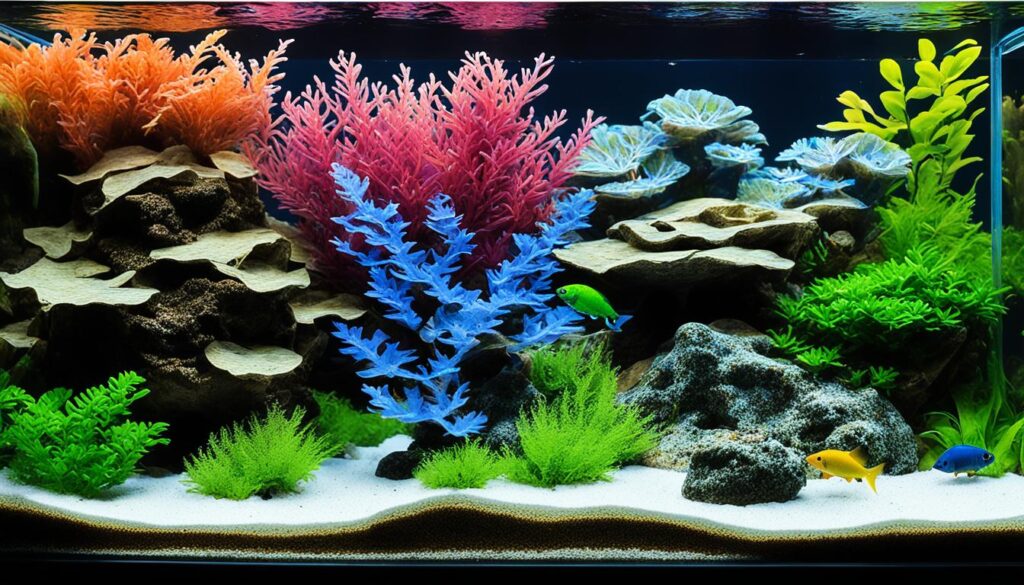
Installation and Maintenance of Aquarium Substrate
Installing the right aquarium substrate is essential for creating a healthy and vibrant freshwater aquarium. Once you have chosen the perfect substrate for your tank, it is important to follow proper installation and maintenance procedures to ensure its longevity and effectiveness. In this section, I will guide you through the steps of installing and maintaining your aquarium substrate to create an optimal environment for your aquatic pets.
Installing Aquarium Substrate
Before adding substrate to your aquarium, it is crucial to prepare the tank properly. Clean the tank thoroughly, removing any debris, and rinse it with clean water to remove any residual cleaning agents. Once the tank is clean and dry, you can begin the installation process.
- Carefully pour the substrate into a bucket or container and moisten it if necessary. Some substrates, like sand or soil, may need to be rinsed before use to remove dust and impurities.
- Gently pour the substrate into the aquarium, starting from the back and working your way to the front. Create a sloping effect by adding more substrate at the back and gradually decreasing the depth towards the front.
- Smooth out the substrate using a clean hand or a soft utensil, ensuring an even and level surface. Avoid disturbing the water too much to prevent clouding.
- If you have chosen to incorporate live plants, take care not to bury their roots too deep in the substrate. Consult the specific plant care instructions for proper planting techniques.
Once the substrate is in place, you can begin adding water to the tank. Pour the water slowly and directly onto a plate or a saucer to minimize disturbance to the substrate. Fill the tank to the desired level, taking care not to disturb the substrate bed. Now your aquarium is ready for the next step: maintaining the substrate!
Maintaining Aquarium Substrate
Proper maintenance of the aquarium substrate is key to ensuring a healthy and clean tank. Here are some essential practices to follow:
- Cleaning: Regularly vacuum or stir the substrate to remove debris, uneaten food, and waste. This helps prevent the buildup of harmful substances in the tank and maintains water quality. Use an aquarium gravel vacuum or a gentle stirrer to minimize disturbance to the substrate bed.
- Filter Changes: Clean or replace your aquarium filter according to the manufacturer’s instructions. The filter plays a crucial role in removing impurities from the water and keeping it clean for your fish and plants.
- Water Changes: Perform regular water changes to maintain optimal water parameters. This helps remove excess nutrients and wasteful byproducts that can accumulate in the substrate over time. Follow a schedule of partial water changes, replacing a portion of the water with fresh, conditioned water.
It is important to note that different types of substrates may require specific care. Always refer to the manufacturer’s recommendations for cleaning and maintenance instructions tailored to your chosen substrate. By following these guidelines, you can ensure that your substrate remains clean, functional, and visually appealing, creating a thriving environment for your aquarium inhabitants.

Benefits of Different Aquarium Substrates
Aquarium substrates offer a multitude of benefits for freshwater aquariums. They not only enhance the overall aesthetic appeal of your tank but also provide crucial support for filtration, oxygenation, and the well-being of your fish and plants.
Gravel: Enhancing Filtration and Oxygenation
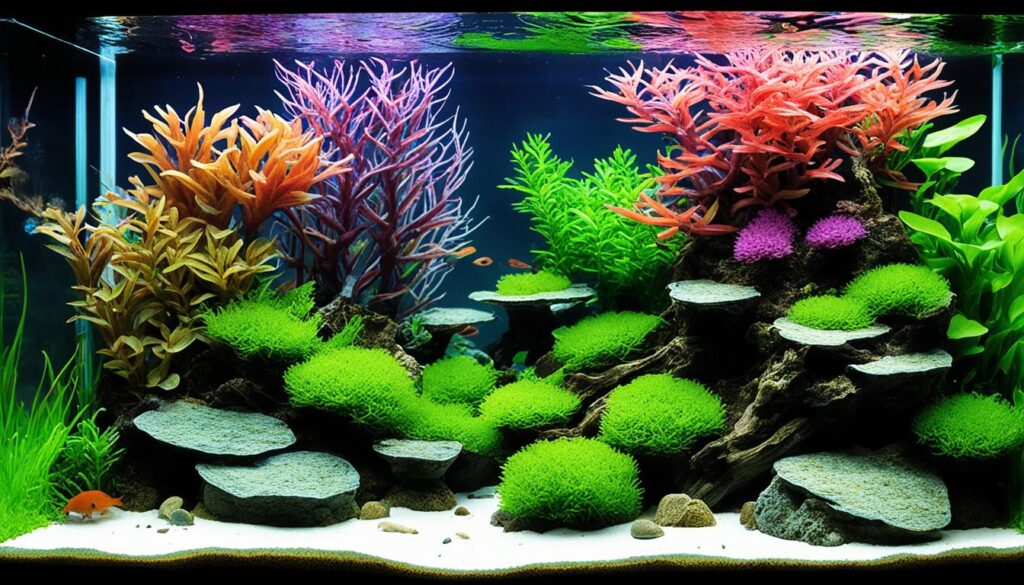 is a popular substrate choice for its many advantages. The porous nature of gravel allows for beneficial bacteria colonization, which aids in the breakdown of waste and the maintenance of water quality. As water passes through the substrate, it gets naturally filtered, providing a healthier environment for your aquarium inhabitants. Additionally, the gaps between gravel particles facilitate oxygenation by allowing water to flow freely, ensuring optimal levels of dissolved oxygen for your fish.
is a popular substrate choice for its many advantages. The porous nature of gravel allows for beneficial bacteria colonization, which aids in the breakdown of waste and the maintenance of water quality. As water passes through the substrate, it gets naturally filtered, providing a healthier environment for your aquarium inhabitants. Additionally, the gaps between gravel particles facilitate oxygenation by allowing water to flow freely, ensuring optimal levels of dissolved oxygen for your fish.
Sand: Suitable for Delicate Fish
Sand is another substrate option that offers unique benefits. With its fine texture, sand is less likely to trap debris, making it easier to clean. This makes it a suitable choice for delicate fish species that are prone to injury from rough substrates. Additionally, the structure of sand prevents waste accumulation, leading to improved water quality. Furthermore, sand provides an attractive appearance that mimics the natural environment of many fish species.
Soil: Nutrient-Rich for Planted Tanks
Soil substrates are specifically designed for planted aquariums. They provide a nutrient-rich medium in which aquatic plants can thrive. The organic matter in soil substrates releases essential nutrients, promoting healthy plant growth and vibrant colors. This creates a beautiful underwater landscape while also improving water quality by absorbing excess nitrates and other pollutants from the water.
Each substrate offers distinct benefits, and the best choice depends on your specific aquarium needs. Whether you prioritize natural filtration, oxygenation, delicate fish requirements, or lush plant growth, selecting the right substrate plays a vital role in maintaining a thriving and visually stunning aquarium.
| Substrate | Benefits |
|---|---|
| Gravel |
|
| Sand |
|
| Soil |
|
Conclusion
After exploring the various aspects of substrate depth in freshwater aquariums, we can conclude that choosing the right depth is essential for the overall health and appearance of your aquarium. By considering the needs of your fish and plants, the size of your tank, and the overall tank setup, you can determine the appropriate substrate depth.
Proper installation and maintenance are paramount to ensure a thriving aquarium. By following the manufacturer’s recommendations and implementing regular cleaning and water changes, you can keep your substrate in optimal condition for the well-being of your aquatic ecosystem.
Additionally, don’t forget the impact of substrate color on your aquarium. By selecting a color that complements the natural environment of your fish, you can create a visually appealing aquarium that brings out the best in your aquatic companions.
In conclusion, a substrate depth guide is a valuable resource for any freshwater aquarium owner. By choosing the right substrate and determining the appropriate depth, you can create a beautiful and healthy habitat for your fish and plants. So, take the time to consider all the factors, install and maintain your substrate properly, and enjoy the rewarding experience of a thriving freshwater aquarium.
FAQ
What is a substrate?
The substrate refers to any loose material that covers the bottom of your aquarium. It can be pebbles, gravel, sand, or soil. The substrate serves various purposes, including enhancing the aquarium’s appearance, creating a natural environment for fish, supporting beneficial bacteria, and providing a rooting medium for plants.
What are the types of substrates for freshwater aquariums?
There are several types of substrates commonly used in freshwater aquariums. Pebbles are the largest type of substrate, but they can lead to food and waste buildup. Gravel is a popular choice as it comes in various sizes and colors, allowing for customization. Sand is a natural substrate that closely replicates the environment of many aquarium fish. Soil is specifically used for planted tanks as it provides nutrients for plant growth.
How do I choose the right substrate for my aquarium?
When choosing a substrate for your aquarium, it’s important to consider the needs of your fish, plants, and the overall tank setup. For planted tanks, soil is recommended to provide nutrients for plant roots. For bottom-dwelling fish, a smooth and rounded substrate is ideal to prevent injuries. The substrate should complement the other elements in your tank and create a cohesive and natural environment.
What is the ideal substrate depth for a freshwater aquarium?
The ideal substrate depth for a freshwater aquarium is at least 3 inches. This depth allows plants to root without floating away and provides a visually pleasing appearance. However, it’s essential to consider the size of your aquarium and the needs of your fish and plants. Avoid excessive substrate depth as it can limit space for other tank elements and increase the difficulty of cleaning.
Does substrate color affect aquariums?
The choice of substrate color is primarily a personal preference, but it can also affect the behavior and visibility of your fish. Natural substrates, like brown or black, create a visually appealing and less distracting environment. Brightly colored substrates can make fish stand out, but they may also cause distractions. It’s important to consider the natural habitat of your fish and choose a substrate color that complements their needs.
How do I install and maintain aquarium substrate?
Installing aquarium substrate involves preparing the tank, moistening the substrate if necessary, and pouring it into the aquarium. It’s important to follow proper cleaning and maintenance routines for your substrate. Regular vacuuming or stirring helps remove debris, while filter changes and water changes maintain water quality. Different substrates require specific care, so it’s essential to follow manufacturer recommendations.
What are the benefits of different aquarium substrates?
Aquarium substrates provide various benefits to freshwater aquariums. Gravel enhances filtration and oxygenation, provides a habitat for beneficial bacteria, and supports aesthetic beauty. Sand improves oxygenation and is suitable for delicate fish. Soil is nutrient-rich and ideal for planted tanks. Different substrates offer unique advantages, so it’s important to choose the one that best suits your aquarium’s specific needs.
